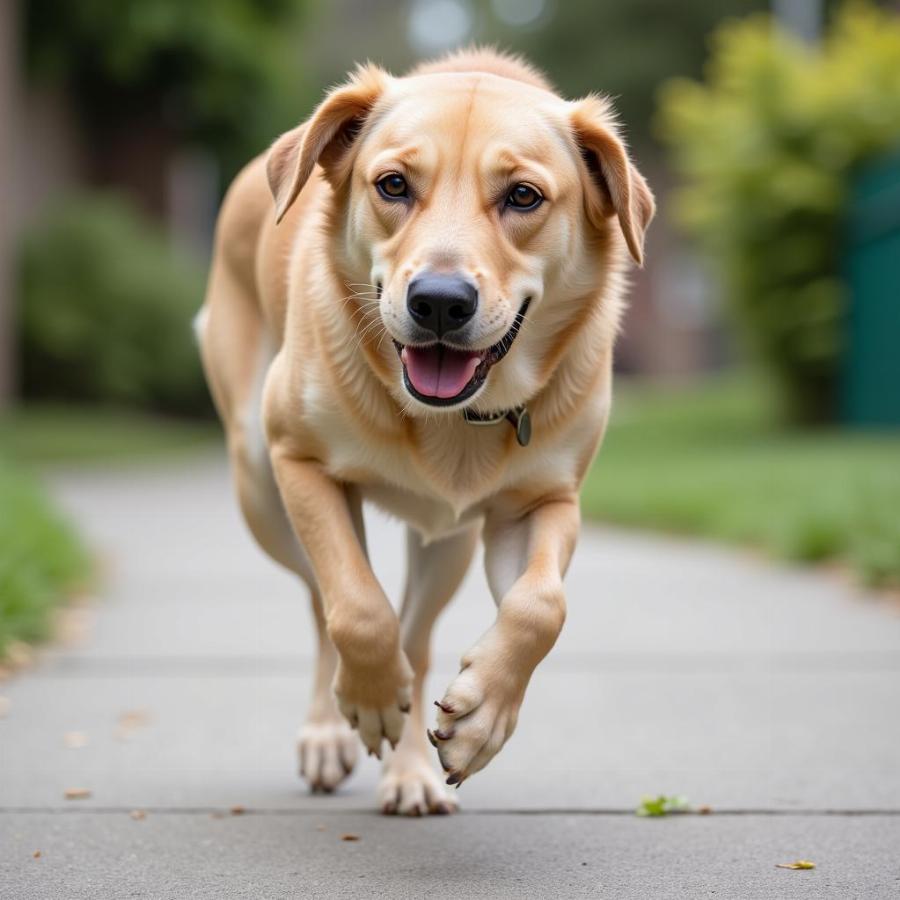Carpus valgus in dogs is a condition that causes the paw to turn outwards. It is a relatively uncommon deformity that affects the front legs, specifically the carpus joint, which is analogous to our wrist. This article will delve into the causes, symptoms, and treatment options for carpus valgus in dogs, equipping you with the knowledge to identify and address this condition should your furry friend ever face it.
Understanding Carpus Valgus
Carpus valgus occurs when there’s an abnormal deviation in the carpus joint, causing the paw to twist outwards. This deviation is often caused by uneven bone growth in the radius and ulna, the two bones that make up a dog’s forearm. While it can affect any breed, certain breeds are genetically predisposed to carpus valgus, including large and giant breeds like Great Danes, German Shepherds, and Irish Wolfhounds.
What Causes Carpus Valgus in Dogs?
The exact causes of carpus valgus are multifaceted and not fully understood. However, several factors are known to contribute to its development:
- Genetics: As mentioned earlier, genetics play a significant role, particularly in large and giant breeds. Puppies born to parents with carpus valgus are more likely to inherit the condition.
- Nutritional Imbalances: Inappropriate calcium and phosphorus levels in a growing puppy’s diet can disrupt normal bone development, potentially leading to carpus valgus and other skeletal problems.
- Trauma: Injuries or fractures to the growth plate in the carpus joint during a puppy’s growth phase can interfere with bone development and lead to deformities like carpus valgus.
Recognizing the Signs: Symptoms of Carpus Valgus
Early detection is crucial for managing carpus valgus effectively. Be attentive to these signs, especially in puppies:
- Outward Turning of the Paw: This is the most obvious symptom, with the paw visibly turning outwards.
- Lameness or Limping: You may notice your dog limping, particularly after exercise or play.
- Abnormal Gait: Dogs with carpus valgus often exhibit an unusual gait, with their front legs appearing bowed or splayed.
- Difficulty Walking or Standing: As the condition progresses, dogs may have difficulty walking or standing for extended periods.
 Dog with Carpus Valgus Walking
Dog with Carpus Valgus Walking
Diagnosing Carpus Valgus
If you suspect your dog might have carpus valgus, a visit to the veterinarian is essential. The vet will perform a thorough physical examination, observing your dog’s gait and range of motion. X-rays are typically necessary to confirm the diagnosis, assess the severity of the deformity, and rule out other potential conditions.
Treatment Options for Carpus Valgus
The treatment approach for carpus valgus depends on the severity of the condition and the dog’s age.
-
Conservative Management: For mild cases in young puppies, conservative management might be sufficient. This may involve:
- Dietary Modification: Ensuring the puppy receives a balanced diet with appropriate calcium and phosphorus levels is crucial. Your vet can recommend a high-quality puppy food formulated for large breeds.
- Controlled Exercise: Limiting strenuous exercise and jumping can help prevent further stress on the developing joints.
- Physical Therapy: Exercises and stretches can help improve muscle strength and joint flexibility.
-
Surgical Intervention: In more severe cases or when conservative management is ineffective, surgery may be necessary to correct the deformity. Surgical options include:
- Corrective Osteotomy: This procedure involves cutting and realigning the bones in the forearm to correct the angle of the carpus joint.
- Guided Growth Procedures: These techniques use implants to guide the growth of the bones in a straighter alignment. They are usually more successful in younger dogs while their bones are still growing.
Living with Carpus Valgus: Prognosis and Management
The prognosis for dogs with carpus valgus varies depending on the severity of the condition and the chosen treatment approach. Early detection and intervention significantly improve the chances of a positive outcome.
After treatment, whether conservative or surgical, a well-structured rehabilitation plan is essential to help your dog regain full function and mobility. This may involve:
- Physical Therapy: Continued physical therapy exercises are crucial for strengthening muscles, improving joint range of motion, and building endurance.
- Weight Management: Maintaining a healthy weight is essential to minimize stress on the affected joints.
- Regular Veterinary Checkups: Regular checkups with your veterinarian allow for monitoring the condition’s progression and addressing any potential complications.
FAQs about Carpus Valgus in Dogs
Can carpus valgus in dogs be prevented?
While you can’t completely eliminate the risk, especially with genetic predisposition, providing a balanced diet and ensuring appropriate exercise during puppyhood can support healthy bone development.
Is carpus valgus painful for dogs?
The level of discomfort varies. Some dogs may show only mild signs, while others experience significant pain and lameness.
How long does it take for carpus valgus to heal after surgery?
Recovery time varies depending on the surgical procedure, the dog’s age, and overall health. Generally, it takes several weeks to months of restricted activity and rehabilitation for complete healing.
Need More Help?
Understanding carpus valgus is crucial for any dog owner, especially those with large breed puppies. If you have any concerns about your furry friend, don’t hesitate to reach out to a veterinarian for expert advice and guidance.
For personalized support and answers to your questions about carpus valgus and other dog health concerns, contact the experts at Beaut Dogs** at [email protected]. We’re dedicated to providing you with reliable and compassionate information to help you keep your canine companion happy and healthy.